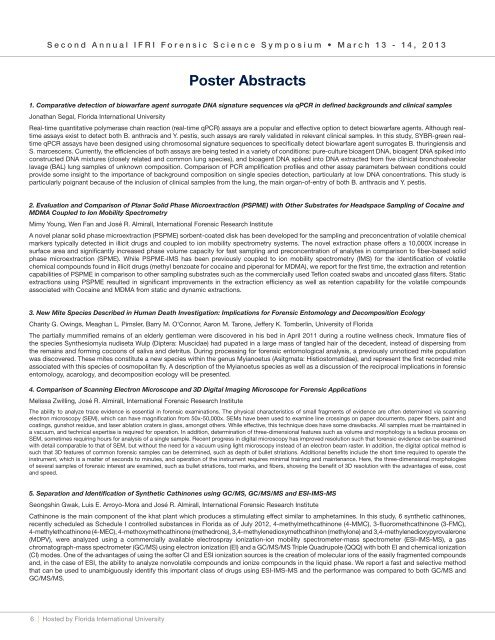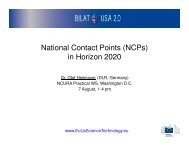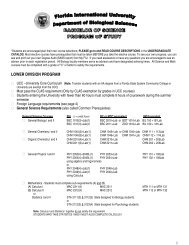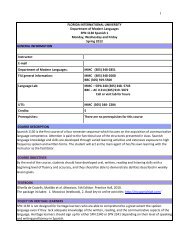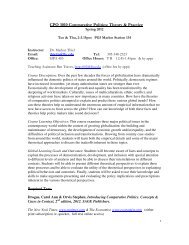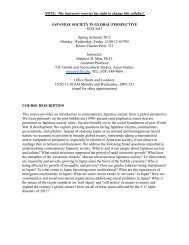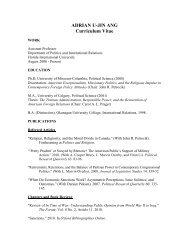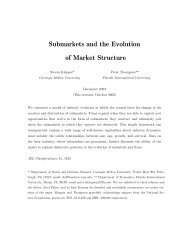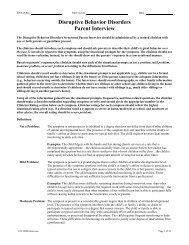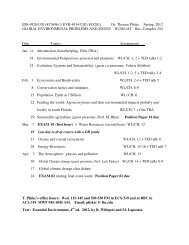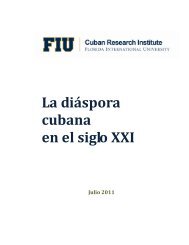Second Annual IFRI Forensic Science Symposium - College of Arts ...
Second Annual IFRI Forensic Science Symposium - College of Arts ...
Second Annual IFRI Forensic Science Symposium - College of Arts ...
You also want an ePaper? Increase the reach of your titles
YUMPU automatically turns print PDFs into web optimized ePapers that Google loves.
<strong>Second</strong> <strong>Annual</strong> <strong>IFRI</strong> <strong>Forensic</strong> <strong>Science</strong> <strong>Symposium</strong> • March 13 - 14, 2013<br />
6 | Hosted by Florida International University<br />
Poster Abstracts<br />
1. Comparative detection <strong>of</strong> biowarfare agent surrogate DNA signature sequences via qPCR in defined backgrounds and clinical samples<br />
Jonathan Segal, Florida International University<br />
Real-time quantitative polymerase chain reaction (real-time qPCR) assays are a popular and effective option to detect biowarfare agents. Although realtime<br />
assays exist to detect both B. anthracis and Y. pestis, such assays are rarely validated in relevant clinical samples. In this study, SYBR-green realtime<br />
qPCR assays have been designed using chromosomal signature sequences to specifically detect biowarfare agent surrogates B. thuringiensis and<br />
S. marcescens. Currently, the efficiencies <strong>of</strong> both assays are being tested in a variety <strong>of</strong> conditions: pure-culture bioagent DNA, bioagent DNA spiked into<br />
constructed DNA mixtures (closely related and common lung species), and bioagent DNA spiked into DNA extracted from five clinical bronchoalveolar<br />
lavage (BAL) lung samples <strong>of</strong> unknown composition. Comparison <strong>of</strong> PCR amplification pr<strong>of</strong>iles and other assay parameters between conditions could<br />
provide some insight to the importance <strong>of</strong> background composition on single species detection, particularly at low DNA concentrations. This study is<br />
particularly poignant because <strong>of</strong> the inclusion <strong>of</strong> clinical samples from the lung, the main organ-<strong>of</strong>-entry <strong>of</strong> both B. anthracis and Y. pestis.<br />
2. Evaluation and Comparison <strong>of</strong> Planar Solid Phase Microextraction (PSPME) with Other Substrates for Headspace Sampling <strong>of</strong> Cocaine and<br />
MDMA Coupled to Ion Mobility Spectrometry<br />
Mimy Young, Wen Fan and José R. Almirall, International <strong>Forensic</strong> Research Institute<br />
A novel planar solid phase microextraction (PSPME) sorbent-coated disk has been developed for the sampling and preconcentration <strong>of</strong> volatile chemical<br />
markers typically detected in illicit drugs and coupled to ion mobility spectrometry systems. The novel extraction phase <strong>of</strong>fers a 10,000X increase in<br />
surface area and significantly increased phase volume capacity for fast sampling and preconcentration <strong>of</strong> analytes in comparison to fiber-based solid<br />
phase microextraction (SPME). While PSPME-IMS has been previously coupled to ion mobility spectrometry (IMS) for the identification <strong>of</strong> volatile<br />
chemical compounds found in illicit drugs (methyl benzoate for cocaine and piperonal for MDMA), we report for the first time, the extraction and retention<br />
capabilities <strong>of</strong> PSPME in comparison to other sampling substrates such as the commercially used Teflon coated swabs and uncoated glass filters. Static<br />
extractions using PSPME resulted in significant improvements in the extraction efficiency as well as retention capability for the volatile compounds<br />
associated with Cocaine and MDMA from static and dynamic extractions.<br />
3. New Mite Species Described in Human Death Investigation: Implications for <strong>Forensic</strong> Entomology and Decomposition Ecology<br />
Charity G. Owings, Meaghan L. Pimsler, Barry M. O‘Connor, Aaron M. Tarone, Jeffery K. Tomberlin, University <strong>of</strong> Florida<br />
The partially mummified remains <strong>of</strong> an elderly gentleman were discovered in his bed in April 2011 during a routine wellness check. Immature flies <strong>of</strong><br />
the species Synthesiomyia nudiseta Wulp (Diptera: Muscidae) had pupated in a large mass <strong>of</strong> tangled hair <strong>of</strong> the decedent, instead <strong>of</strong> dispersing from<br />
the remains and forming cocoons <strong>of</strong> saliva and detritus. During processing for forensic entomological analysis, a previously unnoticed mite population<br />
was discovered. These mites constitute a new species within the genus Myianoetus (Asitgmata: Histiostomatidae), and represent the first recorded mite<br />
associated with this species <strong>of</strong> cosmopolitan fly. A description <strong>of</strong> the Myianoetus species as well as a discussion <strong>of</strong> the reciprocal implications in forensic<br />
entomology, acarology, and decomposition ecology will be presented.<br />
4. Comparison <strong>of</strong> Scanning Electron Microscope and 3D Digital Imaging Microscope for <strong>Forensic</strong> Applications<br />
Melissa Zwilling, José R. Almirall, International <strong>Forensic</strong> Research Institute<br />
The ability to analyze trace evidence is essential in forensic examinations. The physical characteristics <strong>of</strong> small fragments <strong>of</strong> evidence are <strong>of</strong>ten determined via scanning<br />
electron microscopy (SEM), which can have magnification from 50x-50,000x. SEMs have been used to examine line crossings on paper documents, paper fibers, paint and<br />
coatings, gunshot residue, and laser ablation craters in glass, amongst others. While effective, this technique does have some drawbacks. All samples must be maintained in<br />
a vacuum, and technical expertise is required for operation. In addition, determination <strong>of</strong> three-dimensional features such as volume and morphology is a tedious process on<br />
SEM, sometimes requiring hours for analysis <strong>of</strong> a single sample. Recent progress in digital microscopy has improved resolution such that forensic evidence can be examined<br />
with detail comparable to that <strong>of</strong> SEM, but without the need for a vacuum using light microscopy instead <strong>of</strong> an electron beam raster. In addition, the digital optical method is<br />
such that 3D features <strong>of</strong> common forensic samples can be determined, such as depth <strong>of</strong> bullet striations. Additional benefits include the short time required to operate the<br />
instrument, which is a matter <strong>of</strong> seconds to minutes, and operation <strong>of</strong> the instrument requires minimal training and maintenance. Here, the three-dimensional morphologies<br />
<strong>of</strong> several samples <strong>of</strong> forensic interest are examined, such as bullet striations, tool marks, and fibers, showing the benefit <strong>of</strong> 3D resolution with the advantages <strong>of</strong> ease, cost<br />
and speed.<br />
5. Separation and Identification <strong>of</strong> Synthetic Cathinones using GC/MS, GC/MS/MS and ESI-IMS-MS<br />
Seongshin Gwak, Luis E. Arroyo-Mora and José R. Almirall, International <strong>Forensic</strong> Research Institute<br />
Cathinone is the main component <strong>of</strong> the khat plant which produces a stimulating effect similar to amphetamines. In this study, 6 synthetic cathinones,<br />
recently scheduled as Schedule I controlled substances in Florida as <strong>of</strong> July 2012, 4-methylmethcathinone (4-MMC), 3-fluoromethcathinone (3-FMC),<br />
4-methylethcathinone (4-MEC), 4-methoxymethcathinone (methedrone), 3,4-methylenedioxymethcathinon (methylone) and 3,4-methylenedioxypyrovalerone<br />
(MDPV), were analyzed using a commercially available electrospray ionization-ion mobility spectrometer-mass spectrometer (ESI-IMS-MS), a gas<br />
chromatograph-mass spectrometer (GC/MS) using electron ionization (EI) and a GC/MS/MS Triple Quadrupole (QQQ) with both EI and chemical ionization<br />
(CI) modes. One <strong>of</strong> the advantages <strong>of</strong> using the s<strong>of</strong>ter CI and ESI ionization sources is the creation <strong>of</strong> molecular ions <strong>of</strong> the easily fragmented compounds<br />
and, in the case <strong>of</strong> ESI, the ability to analyze nonvolatile compounds and ionize compounds in the liquid phase. We report a fast and selective method<br />
that can be used to unambiguously identify this important class <strong>of</strong> drugs using ESI-IMS-MS and the performance was compared to both GC/MS and<br />
GC/MS/MS.


